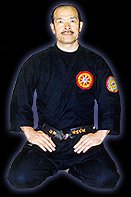BUJUTSU TRAINING
The traditional Japanese martial arts (bujutsu) are NOT like a sport, a competition governed by rules. The real enemies of body, mind, and spirit attack without warning and follow no rules. We prepare to defeat these enemies by training, "keiko" and "shugyō" in Japanese.
|
稽 古 KEIKO, TRAINING
The most common type of activity associated with the traditional martial arts is 稽 古 keiko. The term keiko is composed of two Kanji (Chinese) characters: the first, 稽 kei, means “to cogitate,” “to think,” or “to consider”; the second, 古 ko, literally 10 mouths or generations, is rendered “old” or “ancient.” Therefore, the verb Keiko is usually translated, "to involve oneself in a process." However, when the meaning of the Kanji is fully considered, keiko really means "to meditate on the old or ancient." |
We find this reference to ancient things particularly significant as the kata we "meditate" on are often very old. In keiko training we focus on kata, repeating them over and over until they can be performed without thought. The traditional way of learning is to imitate the master, to learn his movements down to the smallest detail. According to Grandmaster Tanemura, when we observe his movements (during a kata), we are seeing the movements of his predecessors.
|
修 行 SHUGYO, SEVERE TRAINING
A less common but equally important activity associated with traditional martial arts is 修行 shugyō. The term, shugyō, is composed of two Kanji (Chinese) characters. The first character, 修 shu, means to “study,” “cultivate,” or “master.” The second character, 行 ko/gyō, means to “do,” “proceed,” or “carry out.” When combined, these characters are normally translated as "training” or “ascetic practice.” In the traditional bujutsu, the term shugyō carries strong Buddhist associations that are rooted in China, where monastic practice and asceticism was referred to as shugyō and one who engaged in such practice, a shugyōsha. Buddhist shugyō is training done in pursuit of higher (deeper) levels of consciousness and the refinement of one’s physical, mental, and spiritual capabilities. Therefore, when its association with the Buddhist tradition is considered, the term shugyō implies a very demanding or severe training experience that profoundly affects the whole person.
|
In the past, severe training was the proper way to prepare for a real attack, but nowadays people tend to avoid it as much as possible. Sometimes being fierce or withstanding violence is part of the art of self protection. When your life is in danger and you are totally involved in survival, severe training can help you endure hardship and injury. Easy training will not make it possible to protect yourself from danger or a real attack. |
CONTACT US
Anyone can learn traditional Japanese martial arts. All that is needed is a sincere desire to learn and perseverance. If you are sincere in your desire to learn traditional Japanese martial arts and willing to commit to regular training, we invite you to contact us.
Anyone can learn traditional Japanese martial arts. All that is needed is a sincere desire to learn and perseverance. If you are sincere in your desire to learn traditional Japanese martial arts and willing to commit to regular training, we invite you to contact us.
|
Unryu Dojo is an official branch of the Genbukan Honbu Dojo, Saitama, Japan, Shoto Tanemura headmaster (soke/soshi) and president (kancho). SamuraiTrainingCenter.com, PhillySamurai.com, and PhillyNinja.com are registered domains of Unryu Dojo. © 2009-2024 Unryu Dojo. All rights reserved. Reproduction in whole or in part in any form without express permission is strictly prohibited.
Anyone can learn traditional Japanese martial arts. All that is needed is a sincere desire to learn and perseverance. If you are sincere in your desire to learn, we invite you to contact us. |


